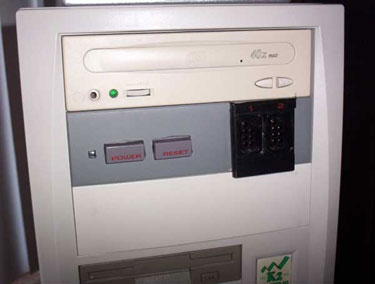It’s been a while since I’ve mentioned anything about my little media server so I guess I should start by explaining that “The Box” is a puny 400MHz machine with a humongous hard drive. It is hooked into our home entertainment system, and although it isn’t very fast, it’s great for playing music, movies, and of course, Nintendo games.

Since this picture was taken, it has been spray painted black, but it’s still the same die-hard trooper on the inside. The Nintendo looking panel on the front actually has the controller ports and buttons from an actual NES mounted on it. The buttons don’t really do anything yet, but the controller ports are wired to power and a parallel port so that my old Nintendo pads can be used as joysticks for NES emulator games. It’s just like having the old Nintendo working again, without blowing on cartridges and having the picture quality randomly go all pixelated.
The only wires connected to “The Box” are power, network, sound, and SVideo. I don’t have a monitor, keyboard, or a mouse hooked up to it, so the only display is the TV, and the only way to control it is remotely. I have the storage drive (aka The Monster) mapped on our 2 other computers, so accessing files is a snap. I also have Winamp set to run on startup and have Wawi setup to make playing music on the box easy as well.
Accessing “The Box” from remote desktop works great for using it like a server. I can login to it from the home computers or even at work to check on torrents and grab documents and pictures. Problems come in however, when we want to watch movies or play Nintendo from it. Because Remote Desktop logs the local user out when you log in remotely, there was no way to see the display on the TV when you are logged in from another computer.
Every time we wanted to watch a movie, or play Nintendo, I had to steal the keyboard and mouse from another computer. That got old really fast, and I’ve been looking for a solution to this problem for a while now. Last week, I found the option I was looking for. Enter Virtual Network Computing. VNC is a cross-platform software app developed by AT&T Labs that’s been around since 1998. It works very much like Remote Desktop, but with a lot more options. One of those options being the ability to leave the local user logged in when you log in remotely. That means I can login to the computer wirelessly from our laptop, and see my mouse move around on the laptop screen, as well as the TV.
Genius!
Man. I haven’t used VNC in a really long time. We started messing around with it in 99 and had some really good times in college (leave webcam on, speakers up loud, vnc to dorm computer from class, start playing a song, watch roommate fall out of chair).
I don’t think I’ve used it since sophomore year when I got tired of the wicked lag. I also had trouble polling fullscreen, so it was super slow to respond and you had to scroll all over to get anywhere.
I’m assuming that’s much better with a decent graphics card and reasonable processing speed. Does it really work well now?
It’s hard to say whether or not it works “well”. The server is only 400MHz, so there is some lag, but much less lag than in Remote Desktop.
That sounds like the type of stunt that my roommate Jhon and I used to pull in college. Memories…
Maybe I missed something, but why don’t you have inputs?
For ours, we just use a wireless keyboard and mouse. Sure, it takes a bit of fiddling with the resolution, but it is far more convenient than having to go to another room to change the movie, music video or tunes
I mean, VNC is cool but I’m not sure you’d want to use it all the time?
I don’t have inputs mainly for aesthetic reasons. The Box looks nice next to the entertainment system, but not with a mouse and keyboard sitting on it. When I need to hook up a mouse and keyboard, I do usually use our wireless set, but I don’t have another keyboard and mouse set to dedicate to it full time. The laptop sits on a desk in the same room, so it’s no problem to do everything remotely all the time.
Fair enough
Our inputs just live on a little shelf under the coffee table so they are only visible when in use, but if you have the laptop there anyway, then sure